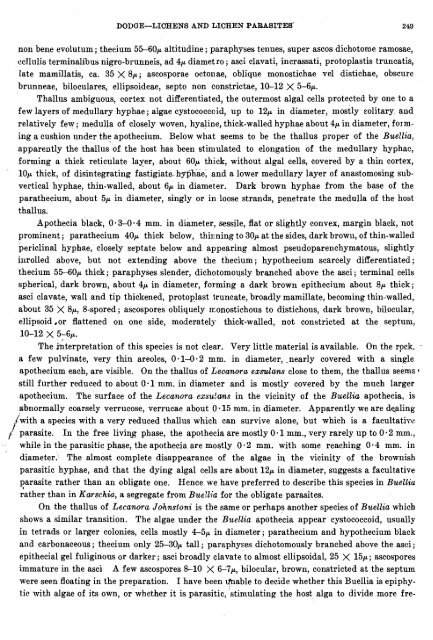You also want an ePaper? Increase the reach of your titles
YUMPU automatically turns print PDFs into web optimized ePapers that Google loves.
DODGE-<strong><strong>LICHEN</strong>S</strong> <strong>AND</strong> <strong>LICHEN</strong> PARASITEE' 240<br />
non bene evolutum ; thecium 55-6OP altitudine ; paraphgses tennes, super ascos dichotome ramosae,<br />
ccllulis terminalibns nigro-brunneis, ad 4 ,~ diamet ro ; asci clavati, incrassati, protoplastis truncatis,<br />
late mamillatis, ca. 35 X 8 ~ ascosporae ; octonae, oblique monostichae vel distichae, obscure<br />
brnnneae, biloculares, ellipsoideae, septo non constrictae, 10-12 X 5-6~.<br />
Thallils ambiguous, cortex not differentiated, the outermost algal cells protected by one to a<br />
few layers of medullary hyphae; algae cystococc~id, up to 1 2 in ~ diameter, mostly eolitary and<br />
relatively few ; medulla of closely woven, hyaline, thick-walled hyphae about 4p in diameter, forming<br />
a cushion under the apothecium. Below what seems to be the thallus proper of the Buellia,<br />
apparently the thallus of the host has been stimulated to elongation of the medullary hyphae,<br />
forming a thick reticulate laxer, about 6OP thick, without algal cells, covered by a thin cortex,<br />
lor. thick, of disintegrating fastigiate h;7rp?lae, and a lower medullary layer of anastomosing subvertical<br />
hyphae, thin-walled, about 6~ in diameter. Dark brown hyphae from the base of the<br />
parathecium, about 5~ in diameter, singly or in loose strands, penetrate the medulla of the host<br />
thallus.<br />
Apothecia black, 0.3-0-4 mm. in diameter, sessile, flat or slightly convex, margin black, not<br />
prominent ; parathecium 4OP thick below, thirning to 3OP at the sides, dark brown, of thin-walled<br />
periclinal hyphae, closely septate below and appearing almost pseudoparenchymatous, slightly<br />
illrolled above, but not extending above the thecium; hypothecium scarcely differentiated;<br />
thecium 55-6OP thick; paraphyses slender, dichotomously branched above the asci ; terminal cells<br />
spherical, dark brown, about 4~ in diameter, forming a dark brown epithecium about 8~ thick;<br />
asci clavate, wall and tip thickened, protoplast truncate, broadly mamillate, becoming thin-walled,<br />
about 35 X 8p, &pored; ascospores obliquely aonostichous to distichous, dark brown, bilocular,<br />
ellipsoid ,or flattened on one side, mcxderatel~ thick-walled, not constricted at the septum,<br />
10-12 X 5-6~.<br />
The interpretation of this species is not clear. Very little material is available. On the rpck, -<br />
a few pulvinate, very thin areoles, 0.1-0.2 mm. in diameter, *nearly covered with a single<br />
apothecium each, are visible. On the thallus of Lecanora exmlans close to them, the thallus seems A<br />
still further reduced to about 0.1 mm. in diameter and is mostly covered by the much larger<br />
apothecium. The surface of the Lecanora exsu!ms in the vicinity of the Buellia apothecia, is<br />
abnormally coarsely verrucose, verrucae about 0 ~ 15 mm. in diameter. Apparently we are dealing<br />
{with a species with a very reduced thallus which can survive alone, but which is a facultative<br />
j'<br />
f parasite. In the free livin-g phase, the apothecia are mostly 0.1 mm., very rarely up to 0.2 mm.,<br />
while in the parasitic phase, the apothecia are mostly 0.2 mm. with some reaching 0-4 mm. in<br />
diameter. The almost complete disappearance of the algae in the vicinity of the brownish<br />
parasitic hyphae, and that the dying algal cells are about 1 2 in ~ diameter, suggests a facultative<br />
parasite rather than an obligate one. Hence we have preferred to describe this species in Bz~elliu<br />
rather than in Karschia, a segregate from Bue!lia for the obligate parasites.<br />
On the thallus of Lecanora Johnstoni is the same or perhaps another species of Buellia which<br />
shows a similar transition. The algae under the Bztellia apothecia appear cystococcoid, usually<br />
in tetrads or larger colonies, cells mostly 45,~ in diameter; parathecium and hypothecinm black<br />
and carbonaceous ; thecinm only 25-3OP tall ; paraphyses dichotomously branched above the asci ;<br />
epithecial gel fuliginous or darker; asci broadly clavate to almost ellipsoidal, 25 X 15~; ascospores<br />
immature in the asci A few ascospores 8-10 X 6-7~, bilocular, brown, constricted at the septum<br />
were seen floating in the preparation. I have been dnable to decide whether this Buellia is epiphytic<br />
with algae of its own, or whether it is parasitic, 'stimulating the host alga to divide more fre-

















